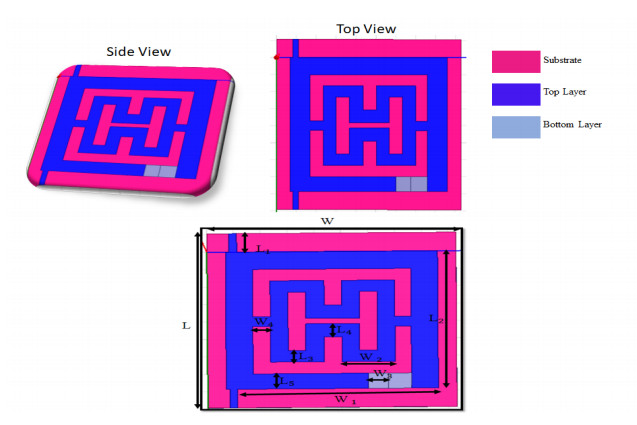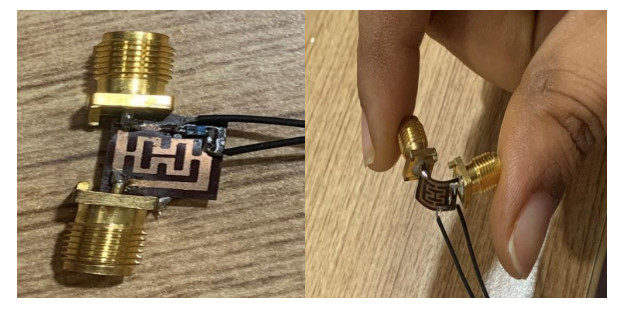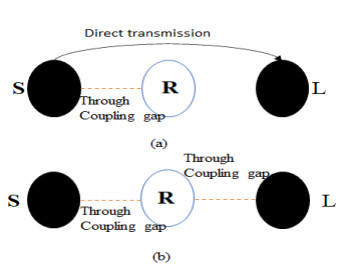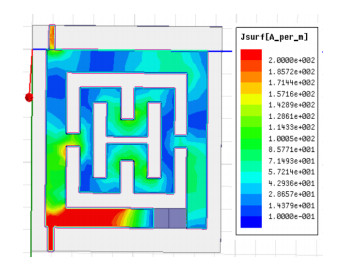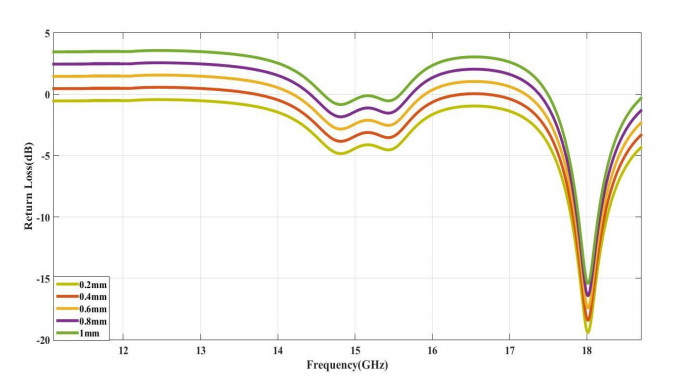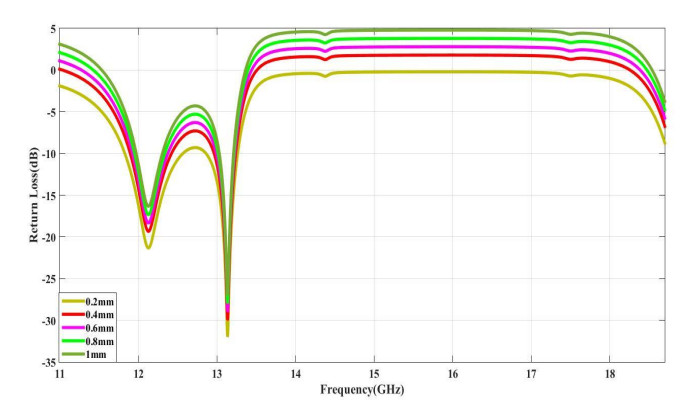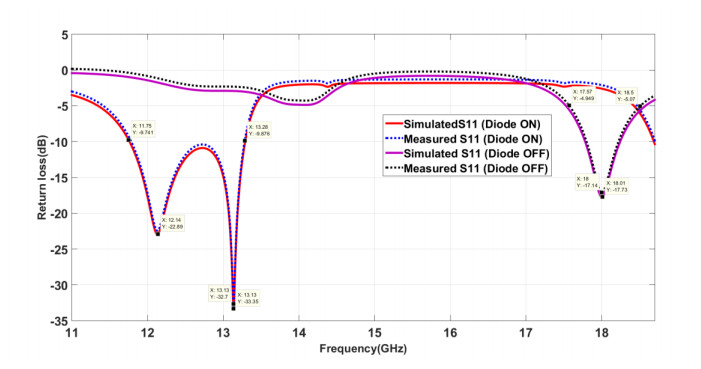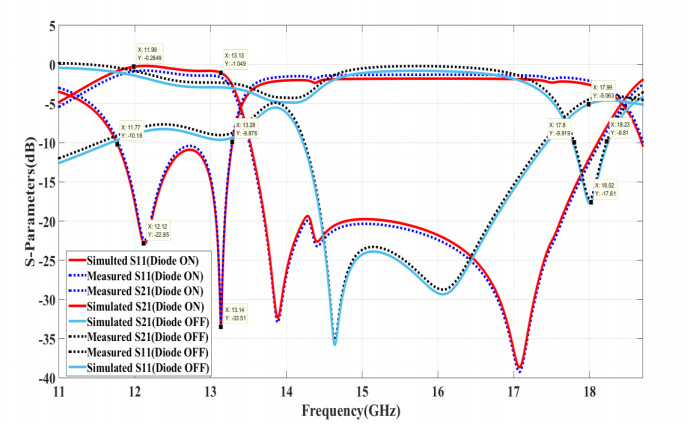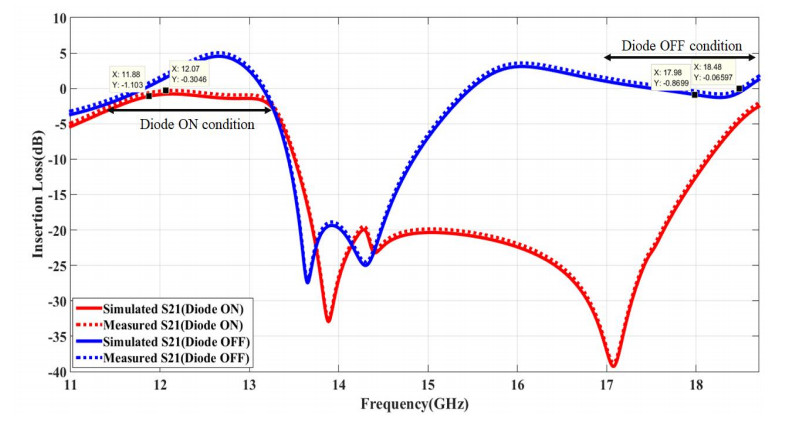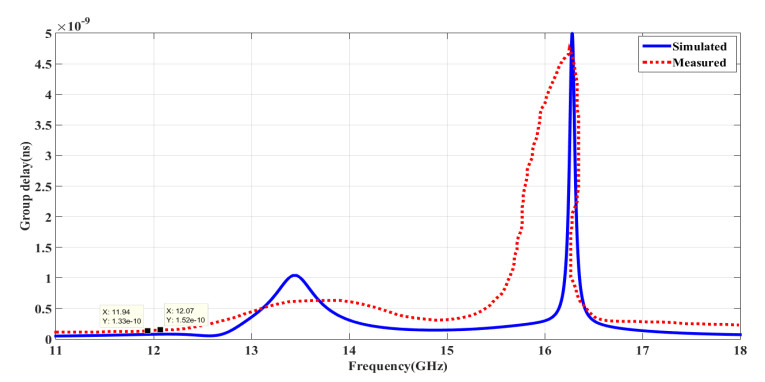1.
Introduction
In order to utilise the spectrum effectively, the ITU partitioned the world into three regions for satellite applications. FSS in receive mode and transmit mode employs the frequency ranges in region-3 are 12.2 to 12.7 GHz and 14 to 14.5 GHz. DBS uses frequencies of 11.7 to 12.2 GHz for reception and 17.3 to 17.8 GHz for transmission. Many wireless standards exist today works with its own operational frequency such as, Wi-Fi operates at 2.4 and 5GHz, GSM operates at 800-900 MHz and 1800-1900 MHz, C and KU bands are used for satellite communications, operates at 4-8 GHz and 12-18 GHz respectively. In order to address the limits of environment and space, low profile, compact size, light weight, and dual-band microstrip based devices are well suited for satellite communication applications. Traditional RF filters often cover only one frequency band, requiring a large number of filters in a wireless system, increasing the system's size and cost. Decreasing the number or size of filters in a wireless communication system can help in cost and size reduction. Frequency reconfigurable filters, which can shift their operating band on demand, could solve this problem. Wearable wireless gadgets are another emerging trend, which requires electronics that are conformal to the human body in order to be easy to use. Flexible and lightweight filters are usually needed because of their low cost and small size.
There has been a lot of research and development on reconfigurable filters, as described in the literature. Frequency or bandwidth reconfigurable filters are the most common categories in this literature. The pass edges can be made tunable individually or simultaneously, focusing on bandwidth reconfigurability. The bandwidth between a narrow and a wideband condition is controlled by a pin diode on the п-shaped structure of the ring resonator [1]. Using pin diodes in cross-shaped resonators, switching between three different bandwidth states has been made easier [2]. The pass edges were tuned simultaneously using a combination of open-ended stubs, terminated cross-shaped resonators, and parallel connected lines [3]. Using resonators such as uniform resonator and open loop [4] and a pin diode as an actuator, switching between 3 different widths has also been accomplished. The electronically reconfigurable filter's bandwidth was changed using the transversal filtering section in [4]. Bandwidth reconfiguration is also possible on a coplanar waveguide transmission line [5] by inserting varactors at appropriate positions on the transmission line. Separate efforts have also been made to rearrange the two pass edges. The lower pass edge has been independently tuned by tuning the capacitance value of the capacitor set in a fifth order LC circuit [7]. Filters with individually reconfigurable pass edges are required to be built by combining any two types of reconfigurations in a single device, compound reconfigurations have also been achieved in filters combining center frequency with bandwidth reconfigurability was the most concentrated of them. Frequency and bandwidth reconfigurable bandpass filter have been built using quasi elliptical topology [8]. To incorporate both frequency and bandwidth reconfigurability, a dual mode resonator embedded with a T-shaped varactor was used [9]. With the use of variable capacitors, these functionalities have also been added to the comb line filter [10]. Parallel-coupled switching electric circuits [11] and dual-mode loop resonators fixed with varactors have also been used to design compound reconfigurable filters. Varactors are also used to tune frequency and bandwidth on hairpin filters [14] and resonator coupled transmission lines [15]. Spiral feeding lines and T-shaped resonators are used for reconfigurable filters [16]. Pin diodes are used for reconfigurability [17]. Dual band BPF embedded in a LTCC is used in the filter designing [18]. Tri band BPF is designed and Pin diode is used for reconfigurability [19], varactor diodes are used for designing the reconfigurable band pass filters [20]. A quad mode bandpass filter is designed by using stubs is shown in [21]. A wide band BPF is designed at KU band for satellite communication applications [22]. A hairpin BPF is designed with DGS is designed at KU band for VSAT system on chip applications [23]. More simple solutions for combined frequency and bandwidth reconfigurable filters may be developed.
This paper proposes the design of a reconfigurable frequency BPF for microwave applications. For simulating the bandpass filter An-soft HFSS, a commercial full-wave EM simulator, was built on a polimide substrate with a thickness of 0.1 mm. Measurements are conducted with an Anritsu combinational analyser MS2037C, the manufactured filter has a compact size, and the results show low loss, good out-of-band rejection, and wide passband covering the frequency bands KU and K. The manufactured filters measurements confirm the design principle and simulation results, and there is good consistency between simulated and measured results.
Section 2 provides an overview and approach for using PIN diodes in filters. Section 3 contains the design of our proposed filter. Section 4 contains simulated and measured outcomes, with section 5 concluding the article.
2.
Design and analysis
2.1. Pin diode model
At RF frequencies, PIN diodes behave like a variable resistor, but with a simpler circuit architecture for ON/OFF states, as represented in Figure 1(a). In both ON and OFF modes, a package inductance L exists. The low resistance Rs of the equivalent circuit in the ON state causes insertion loss (forward biased). During the off state of a pin diode, the equivalent circuit uses a parallel combination of reverse bias resistance RP and total capacitance Cp (reverse biased). All of the values needed for the circuit models can be found on the data sheets provided by the manufacturers for all PIN diodes. The PIN diode is represented in HFSS using two series lumped RLC boundary conditions, as shown in Figure 1(b), with the first half of the RLC boundary being L and the second half being either Rs for the ON state or a parallel combination of Rp and Cp for the OFF state These diodes are utilized to produce a high level of reliability in terms of frequency band reconfiguration.
In our design, we employed an HSCH 5318 PIN diode. The HFSS RLC boundary values for diodes in ON state are L = 0.1 nH and Rs = 5.1 Ω, whereas for diodes in OFF state are Rp = 244 Ω and Cp = 0.16 pF, as per the data sheet provided by the manufacturer. These PIN diodes are used to achieve frequency reconfiguration.
2.2. Design methodology of the reconfigurable BPF
The proposed reconfigurable BPF is made of polimide, which has a dielectric constant of 3.5, a loss tangent of 0.0008 and a thickness of 0.1 mm. The reconfigurable BPF is 10 x 9.2 mm2 in size and Figure 3 represents image of the proposed reconfigurable BPF at flat and bend conditions. The proposed reconfigurable filter is simulated by using HFSS and the design consists of a concentric square loop and a H-shaped resonator and it is designed by attaching 3 quarter wavelength transmission lines. Concentric square loop resonator is designed to resonate the filter at required frequency and the H-shaped resonator is responsible for the transmission zeroes. A diode is placed in the position where the current distribution is maximum and a diode is used to reconfigure between the two frequency bands like KU and K and a HSCH 5318 PIN diode is used for this purpose.
The geometry of the reconfigurable BPF is shown in Figure 2, and the dimensions utilized to design the proposed reconfigurable BPF are shown in Table 1, the frequency reconfigurable filter is simulated for the KU/K band frequency ranges. The concentric square loop resonator of the proposed filter provides two transmission zeros found at the two ends of the passband frequency range as shown in Figure 9. The respective resonators pin diodes are tuned to reconfigure the two transmission zeros. Frequency reconfiguration is so simple and easy when pin diodes are used in a stepped loop structure. The filter provides a direct connection between source and load when the pin diode is in ON condition and the stepped loop structure can transmit frequencies of all types. It is, however, interrupted by the use of resonators, which prevent the corresponding frequencies from reaching the load. When the pin diode is in off condition there is no direct energy transfer between the source and the load, it rejects all frequencies.
Figure 4 presents the coupling diagram of the proposed reconfigurable BPF in the ON and OFF states of the pin diodes. As it is observed that, the resonator does not couple the appropriate frequency to the load in the forward biased condition (ON state), whereas in the reverse biased condition (OFF state), energy is only coupled through the resonator at the frequency for which it is characterized. When the diode is turned on, the current flows from input to output through the stepped loop structure. The forward biased PIN diodes provides a continuous path from port 1 to port 2 by acting as a short circuit. The concentric square loop resonators are made to provide reflections at specific frequencies. Because there is no direct path between the source and the load when the diode is turned off, the current travels through concentric square loops to the output port, where it transmits a single frequency. The open circuited stepped loop reflects the other frequency signals and the filter functions as a narrow band frequency reconfigurable filter in this scenario. Figure 5 represents the surface current distribution of a reconfigurable bandpass filter, which shows signal transmission across square loops.
3.
Results and discussion
The proposed reconfigurable BPF was simulated by using HFSS, and the comparison between the simulated, measured results are shown below. The designed prototype is fabricated and tested in real time for real-time validation. Figure 3 shows an image of the fabricated prototype. Figures 8 and 9 represents simulated and fabricated S-parameter graphs in the KU and K bands. The length and width of the resonator are calculated using the mathematical methods below.
where λg is the guided wavelength, Fr is the resonant frequency and the length of the microstrip resonator is one-fourth of the guided wavelength. As a result, the microstrip is the fundamental structure, and the effective dielectric constant and w/h are calculated using the formulae below.
W is the conductor's width, h is the grounded dielectric substrate's thickness, and εr is the substrate's dielectric constant.
Figures 6 and 7 represent the parametric analysis of the reconfigurable BPF by varying the length of the lumped RLC values during the diode OFF and ON conditions. By varying these lengths, a significant return loss is obtained at the desired frequency 18 GHz (Diode OFF), 12 GHz (Diode ON) and at a frequency of 18 GHz and 11.8-13.4 GHz with a return loss value of -18 dB and -35 dB respectively.
Figure 8 represents the simulated and measured return loss of the reconfigurable BPF during the diode on and off conditions. The reflection coefficient value at both bands is less than -10 dB and in fact lesser than -10 dB, while the insertion loss is less than 3 dB in both cases, as shown in the plots. The proposed reconfigurable BPF resonates at 12 GHz when the diode is in ON condition. The proposed filter offers an impedance bandwidth of 1.7 GHz, reflection coefficient of -25 dB, and transmission coefficient of -2 dB. These S-parameter values may assure its usage for practical applications.
Figure 9 represents the simulated and measured S11 and S21 response of the reconfigurable BPF. When the diode is in ON condition the reconfigurable BPF resonates at 12 GHz and satisfies the requirement of ITU region-3 for FSS transmit services. When the diode is in OFF condition the reconfigurable BPF resonates at 18 GHz and satisfies the requirement of ITU region-3 for DBS reception mode. When the diode is in off condition, there is no direct path between the source and load, the current travels through concentric square loops to the output port, where it transmits a single frequency. The open circuited stepped loop reflects the other frequency signals. The proposed filter functions as a narrow band frequency reconfigurable filter that resonates at 18 GHz and has an impedance bandwidth of 0.5 GHz, a return loss of -18dB, and an insertion loss of < 3 dB, which is ideal for satellite communications, astronomical studies and radars.
Figure 10 represents the simulated and fabricated S21 response of the reconfigurable BPF during diode ON and OFF conditions. The reconfigurable BPF resonates at 12 GHz and 18 GHz and at those frequencies the S21 response of the filter is found to be less than 3 dB and it is 0.3 dB for simulated and 0.9 dB for measured during diode ON condition and in the diode OFF condition S21 is found to be 0.4 dB for simulated and 0.6 dB for measured. The time domain characteristics of the proposed reconfigurable BPF is calculated by using group delay and is shown in Figure 11, the group delay of the suggested filter is maximally flat. The delay induced by the filter is therefore consistent across the operating range, resulting in minimal signal distortion.
The proposed reconfigurable BPF's main critical features are:
1. The reconfigurable BPF is completely adaptable in the frequency range 12–18 GHz.
2. The method is so simple and unique that any complicated and standard methods such as coupling reducers and switched delay lines etc. are prevented from being used.
3. The filter's frequency tuning features are independent. Switching between KU and K band is done by using a pin diode.
4. The proposed reconfigurable BPF has a wide tuning range since it controls the S-parameter response completely between 12 and 18 GHz.
5. Using basic actuators like PIN diodes reduces the fabrication complexity.
6. This filter is fabricated on a less valuable dielectric material, making many operations inexpensive and simple to replicate. Without encroaching additional space, the microstrip resonators are enclosed within the stepped loop structure.
7. By adjusting the size of the square loop resonators, the prototype can be scaled to function at any desired frequency.
Table 2 compares the proposed wideband BPF in this article to various mentioned wide band BPFs in terms of performance. It can be shown that our filters perform better in terms of return loss and insertion loss than the filters in the references of the same size level. Furthermore, among the equivalents, the insertion losses remain the lowest. After comparing the results, it is clear that the proposed reconfigurable bandpass filter proposed in this paper has better bandwidth and insertion loss.
4.
Conclusions
This work describes a unique compound reconfigurable filter that can reconfigure the frequency. The filter is made up of basic concentric square loop resonators that are both scalable and reproducible. The prototype is small, inexpensive, and capable of doing various operations. These types of reconfigurable filters can simply be substituted for filter banks with a large number of filters, reducing the complexity of the transceiver. The designed reconfigurable BPF handles the issues of bandwidth management, efficient spectrum usage, dynamic spectrum access, and many receiver difficulties, making it ideal for future wireless communication devices. The proposed reconfigurable bandpass filter is designed for low transmission co-efficient, steep pass band edges, high out of band rejection and wide bandwidth, with the frequency band covering the transmit mode of FSS services (Diode ON) and reception mode of DBS services (Diode OFF) (ITU region-3) with an insertion loss of 0.2dB and group delay of 0.2ns. In addition, the proposed filter is the first in this field to offer a short group delay and a large bandwidth, meeting ITU Region 3 standards.
Conflict of interest
The authors declare that there is no conflict of interest.










 DownLoad:
DownLoad:
